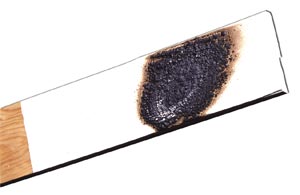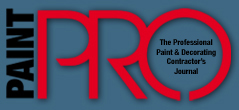Tips on Preparing a Bid that Includes Fire-retardant Coatings
Bidding a painting job that involves intumescent or fire-retardant coatings requires a thorough knowledge of the products and of the substrate beneath them.
by Len Hijuelos
that was of particular interest to me since, at that time, we had recently completed a project using these coatings. I thought I would share with you our experience.
 What I am trying to do in this article is to describe some of the intricacies in dealing with these products and I hope that I don't confuse you (and myself) any further than we might already be. What I am trying to do in this article is to describe some of the intricacies in dealing with these products and I hope that I don't confuse you (and myself) any further than we might already be.
First, there is the matter of terminology. According to the CSI specification format, this type of application should fall under Section 09845 Intumescent Coatings. However, the actual specification, as written, may refer to intumescent coatings, or fire-retardant coatings, or fire-resistant coatings, or possibly even fireproof coatings. Intumescent coatings or fire-retardant coatings may be used interchangeably. I'm not too sure about fire-resistant coatings, while fireproofing is a whole separate animal. A major hurdle here is dealing with an architect or spec writer who has not done their homework and produced a rather superficial specification.
A major problem is dealing with different substrates, specifically wood or metal. The requirements for each substrate are different. Rightly or wrongly, to try to simplify matters to some extent, I've separated the products by referring to applications on wood substrates as architectural in nature, and when dealing with metal as industrial or high-performance applications.
To further complicate matters, there is the development of flame-retardant additives for water-based paints. I have not yet seen any of this specified as yet, so I'm not going to try to discuss that product in this article.
We were very lucky on the project we did in that the fire retardant application was a very small part of the project. The architect had botched up on the specifications, but luckily, we were dealing with a very understanding general contractor. The first mistake I made was that I didn't do my homework; normally when dealing with an unfamiliar product or application I do some extensive research, but in this case I relied on the specification. As it turned out, the spec was quite suitable for the wood substrate, and my pricing was on target. The steel and wrought iron, however, was another story — the cost turned out to be considerably higher than the application on wood. To add to my dilemma, the owners wanted to add quite a bit of ornamental metal to the project, which would require the intumescent coating application. By this time, we were aware of a problem in our pricing and through some diligent research on the Internet, we made contact with a manufacturer's rep who guided us in the right direction — getting our pricing right and also providing insight in dealing with various products and substrates. With this rep's help, we were able to provide enough data to the general contractor to show that the architect had produced a faulty spec.
The point I'm trying to make in this article is that these types of coatings are complicated, and many general contractors may not be familiar with them. The application is too costly to do any "guesstimating." There are a lot of variables that have to be considered, including color selection and topcoats. I have looked at several other projects that involved fire-retardant coatings, and I've found that while I don't have any problems in pricing for wood substrates, I still have problems with metals. My solution, for the time being, is to provide the manufacturer's rep with a detailed take-off, including sizes, weights, etc., of the various members as well as the required fire rating (one-hour, two-hour...), and he in turn will provide me with a complete list of material requirements as well as suggestions about equipment requirements and production factors. I normally don't like this procedure, but in all honesty, it has worked so well for me that I would recommend it to anyone not completely knowledgeable about these applications.

|

